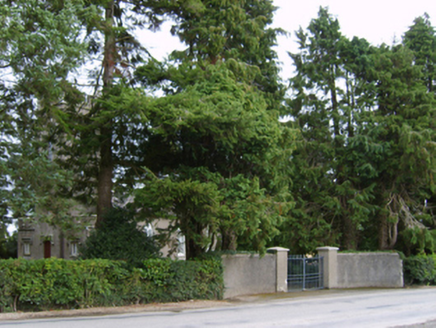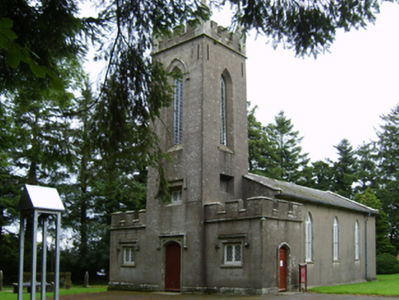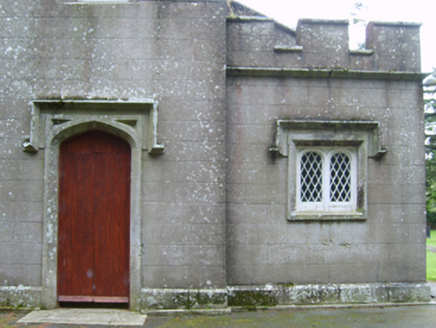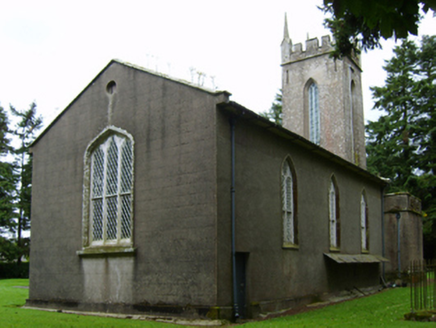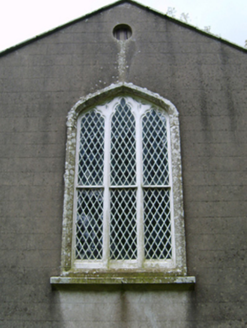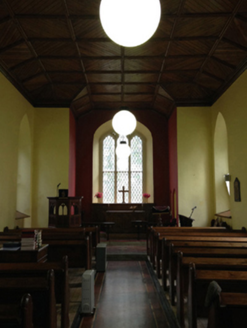Survey Data
Reg No
15702016
Rating
Regional
Categories of Special Interest
Architectural, Artistic, Historical, Scientific, Social
Original Use
Church/chapel
In Use As
Church/chapel
Date
1830 - 1835
Coordinates
300530, 143276
Date Recorded
08/10/2007
Date Updated
--/--/--
Description
Detached three-bay double-height single-cell Board of First Fruits Church of Ireland church, built 1831-3; consecrated 1833, on a rectangular plan with pair of single-bay single-storey vestries centred on single-bay three-stage tower to entrance (west) front on a square plan. Pitched slate roof with lichen-covered clay ridge tiles, cut-granite "saddleback" coping to gables on rendered kneelers, and cast-iron rainwater goods on slightly overhanging rendered eaves retaining "Lotus"-detailed cast-iron octagonal or ogee hoppers and downpipes. Rendered, ruled and lined walls on rendered chamfered plinth; rendered, ruled and lined surface finish to tower on benchmark-inscribed cut-granite chamfered plinth with cut-granite "Cavetto" stringcourse (bell stage) supporting cut-granite diagonal obelisk pinnacles centred on battlemented parapets having cut-granite "saddleback" coping. Pointed-arch window openings with carved timber Y-mullions, and cut-granite surrounds having chamfered reveals framing one-over-one timber sash windows having cast-iron lattice glazing bars. Tudor-headed window opening to chancel (east) with cut-granite sill, carved timber mullions, and cut-granite surround having chamfered reveals framing one-over-one timber sash windows having cast-iron lattice glazing bars. Tudor-headed door opening to tower with granite flagged threshold, and cut-granite surround having chamfered reveals with hood moulding over framing timber boarded double doors having overpanel. Square-headed window opening (second stage), concealed dressings having splayed reveals with hood moulding over framing fixed-pane fitting having cast-iron lattice glazing bars. Lancet openings (bell stage), concealed dressings having splayed reveals with hood moulding over framing applied timber Y-mullions on louvered timber fittings. Interior including vestibule (west); square-headed door opening into nave with timber panelled double doors; full-height interior with herring bone-pattern terracotta tiled central aisle between timber pews, pair of polished brass wall monuments (ob. 1854; 1912), Gothic-style pulpit on an octagonal plan with Gothic-style clerk's desk, terracotta tiled stepped dais to chancel (east) with rosette-detailed balusters supporting communion railing centred on Gothic-style altar below "East Window", and diagonal timber boarded or tongue-and-groove timber panelled vaulted ceiling in carved timber frame on carved timber cornice. Set in landscaped grounds with rendered, ruled and lined piers to perimeter having cut-granite shallow pyramidal capping supporting spear head-detailed wrought iron double gates.
Appraisal
A church erected with financial support from the Board of First Fruits (fl. 1711-1833), and on a site donated by Reverend Solomon Richards JP (1787-1866) of neighbouring Solsborough House (see 15702017), representing an integral component of the early nineteenth-century ecclesiastical heritage of County Wexford with the architectural value of the composition, one recalling the contemporary Ballycarney Church (Ballycarney) (1834), Ballycarney (see 15701510), suggested by such attributes as the standardised nave-with-entrance tower plan form, aligned along a liturgically-correct axis; the "pointed" profile of the openings underpinning a later English Georgian Gothic theme with the chancel defined by a cusped "East Window"; and the pinnacle-topped battlements embellishing the gently tapering tower as a picturesque eye-catcher in the landscape. Having been well maintained, the elementary form and massing survive intact together with substantial quantities of the original fabric, both to the exterior and to the interior where contemporary joinery; wall monuments commemorating General Edwin Richards (1825-54) and Frederick William Richards (1833-1912); and restrained tile work, all highlight the modest artistic potential of a church making a pleasing visual statement in a sylvan setting.
